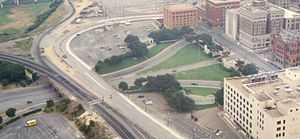Lee Bowers
Lee Edward Bowers, Jr. (January 12, 1925 – August 9, 1966)[1][2] was a key witness to the assassination of John F. Kennedy in Dallas, Texas in 1963.[3] At the moment of the assassination he was operating the Union Terminal Company's two-story interlocking tower, overlooking the parking lot just north of the grassy knoll and west of the Texas School Book Depository. He had an unobstructed view of the rear of the concrete pergola and the stockade fence at the top of the grassy knoll.[4] He described hearing three shots that came from either the Depository on his left or near the mouth of the Triple Underpass railroad bridge on his right; he was unsure because of the reverberation from the shots.

Warren Commission testimony
On April 2, 1964, Lee Bowers provided testimony to Joseph A. Ball, assistant counsel of the Warren Commission, at the US Post Office Building in Dallas.[5] When asked by Ball, "Now, were there any people standing on the high side — high ground between your tower and where Elm Street goes down under the underpass toward the mouth of the underpass?" Bowers testified that at the time the motorcade went by on Elm Street, four men were in the area: one or two uniformed parking lot attendants, one of whom Bowers knew; and two men standing 10 to 15 feet (3 to 5 m) apart near the Triple Underpass, who did not appear to know each other. One was "middle-aged, or slightly older, fairly heavy-set, in a white shirt, fairly dark trousers" and the other was "younger man, about midtwenties, in either a plaid shirt or plaid coat or jacket." One or both were still there when the first police officer arrived "immediately" after the shooting.[6] Many assumed that Bowers meant that these men were standing behind the stockade fence at the top of the grassy knoll.[7]
Rush to Judgment
However, two years later when Bowers was interviewed by assassination researchers Mark Lane and Emile de Antonio for their documentary film Rush to Judgment, he clarified that these two men were standing in the opening between the pergola and the stockade fence, and that "no one" was behind the fence when the shots were fired.[8] Bowers said,
These two men were standing back from the street somewhat at the top of the incline and were very near two trees which were in the area. And one of them, from time to time as he walked back and forth, disappeared behind a wooden fence which is also slightly to the west of that. These two men to the best of my knowledge were standing there at the time of the shooting.
Bowers told Lane that as the motorcade passed "there was a flash of light or smoke" in the vicinity of where the two men were standing.[9]
Employment
Bowers served in the U.S. Navy from ages 17 to 21. He attended Hardin-Simmons University for two years then Southern Methodist University for two years, majoring in religion. He worked for the Union Terminal Co. railyard for 15 years, also working as a self-employed builder. In 1964 he began working as business manager for a hospital and convalescent home.[1]
Death
Bowers died in August, 1966, when his car left an empty road and struck a concrete bridge abutment near Midlothian, Texas.[10][11]
Without evidentiary support, it was alleged in Richard Belzer's book "Hit List" that Bowers's death was murder, not accidental, to cover up knowledge of the JFK assassination [12]
Bowers was played by Pruitt Taylor Vince in the 1991 film JFK.
References
- ↑ 1.0 1.1 Warren Commission Hearings, vol. 6, p. 284, Testimony of Lee E. Bowers, Jr., April 2, 1964.
- ↑ Ancestry.com. Texas Death Index, 1903-2000 [database on-line]. Provo, UT, USA: The Generations Network, Inc., 2006.
- ↑ Warren Commission Report, p. 71–72, The Witnesses: At the Triple Underpass.
- ↑ Warren Commission Report, p. 74, Commission Exhibit 2118, View From North Tower of Union Terminal Company, Dallas, Texas.
- ↑ "Testimony of Lee E. Bowers, Jr.". Hearings Before the President's Commission on the Assassination of President John F. Kennedy, Volume VI. Washington, D.C.: United States Government Printing Office. 1964. pp. 284–288.
- ↑ Warren Commission Hearings, vol. 7, p. 287–288, Testimony of Lee E. Bowers, Jr., April 2, 1964.
- ↑ Mark Lane, Rush to Judgment, Holt, Rinehart & Winston, 1966, p. 31–32:
- "His [Bowers'] description of the two men behind the fence was not unlike Miss Mercer's…"
- "Bowers told a fascinating story of suspicious cars moving in the sealed-off railroad yards minutes before the assassination, and of seeing strange men behind the picket fence."
- "Lee Bowers Jr. … was in the railroad control behind the grassy knoll and saw two men behind the fence, a puff of smoke during the shooting, and a lot of activity."
- "Lee Bowers, the railway towerman who had seen two strangers behind the fence just before the assassination, had partially lost sight of them in the foliage."
- ↑ Rush to Judgment, which advocated a multi-shooter conspiracy, did not use that portion of Bowers' interview. The redacted portions of the Bowers interview were first published by Dale K. Myers in 2004. Dale K. Myers, Secrets of a Homicide: Badge Man — The Testimony of Lee Bowers, Jr. The interview transcript is among the papers of De Antonio at the Wisconsin Historical Society Archives.
- ↑ Mark Lane, Rush to Judgment, Holt, Rinehart & Winston, 1966, p. 31
- ↑ Bugliosi, Vincent (2007). Reclaiming History: The Assassination of President John F. Kennedy. New York: W.W. Norton. p. 899. ISBN 978-0-393-04525-3.
- ↑ "Executive Dies After Car Wreck", The Dallas Morning News, August 10, 1966, p. D4.
- ↑ http://www.bubblews.com/news/2000218-belzer-and-wayne-examine-the-jfk-hit-list
External links
- Biography of Lee Bowers
- Bowers' testimony and Oliver Stone's Film
- Up by the Triple Underpass
- "Lee Bowers". Find a Grave. Retrieved June 11, 2013.